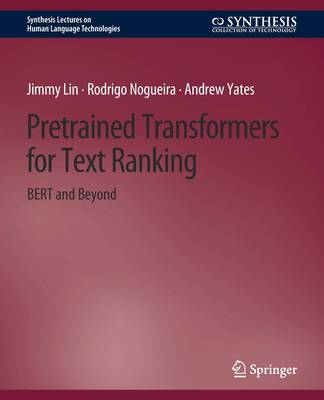
- Afhalen na 1 uur in een winkel met voorraad
- Gratis thuislevering in België vanaf € 30
- Ruim aanbod met 7 miljoen producten
- Afhalen na 1 uur in een winkel met voorraad
- Gratis thuislevering in België vanaf € 30
- Ruim aanbod met 7 miljoen producten
Zoeken
€ 84,45
+ 168 punten
Uitvoering
Omschrijving
The goal of text ranking is to generate an ordered list of texts retrieved from a corpus in response to a query. Although the most common formulation of text ranking is search, instances of the task can also be found in many natural language processing (NLP) applications.This book provides an overview of text ranking with neural network architectures known as transformers, of which BERT (Bidirectional Encoder Representations from Transformers) is the best-known example. The combination of transformers and self-supervised pretraining has been responsible for a paradigm shift in NLP, information retrieval (IR), and beyond. This book provides a synthesis of existing work as a single point of entry for practitioners who wish to gain a better understanding of how to apply transformers to text ranking problems and researchers who wish to pursue work in this area. It covers a wide range of modern techniques, grouped into two high-level categories: transformer models that perform reranking inmulti-stage architectures and dense retrieval techniques that perform ranking directly. Two themes pervade the book: techniques for handling long documents, beyond typical sentence-by-sentence processing in NLP, and techniques for addressing the tradeoff between effectiveness (i.e., result quality) and efficiency (e.g., query latency, model and index size). Although transformer architectures and pretraining techniques are recent innovations, many aspects of how they are applied to text ranking are relatively well understood and represent mature techniques. However, there remain many open research questions, and thus in addition to laying out the foundations of pretrained transformers for text ranking, this book also attempts to prognosticate where the field is heading.
Specificaties
Betrokkenen
- Auteur(s):
- Uitgeverij:
Inhoud
- Aantal bladzijden:
- 307
- Taal:
- Engels
- Reeks:
Eigenschappen
- Productcode (EAN):
- 9783031010538
- Verschijningsdatum:
- 29/10/2021
- Uitvoering:
- Paperback
- Formaat:
- Trade paperback (VS)
- Afmetingen:
- 190 mm x 235 mm
- Gewicht:
- 566 g

Alleen bij Standaard Boekhandel
+ 168 punten op je klantenkaart van Standaard Boekhandel
Beoordelingen
We publiceren alleen reviews die voldoen aan de voorwaarden voor reviews. Bekijk onze voorwaarden voor reviews.











